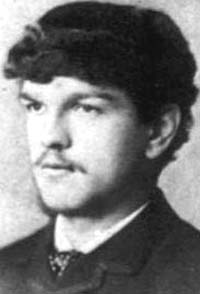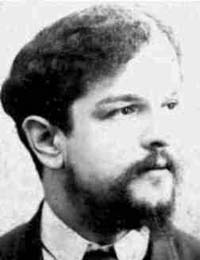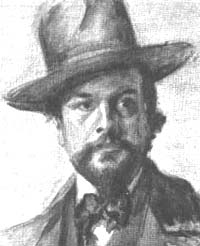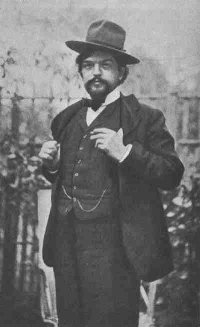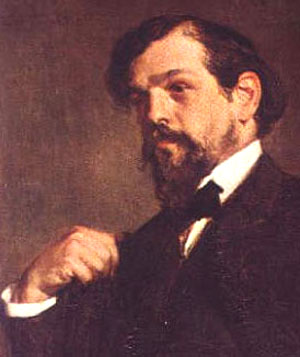Claude Debussy
Copyright Michael D. Robbins 2005
Astro-Rayological Interpretation & Charts
Quotes
Biography
Images and Physiognomic Interpretation
Claude DebussyŚComposer, Founder of Impressionistic School

(Ascendant Leo with Sun conjunct the Ascendant in Leo, and Venus also
in Leo, H12; MC, Taurus with Pluto conjunct the Ascendant; Moon in Cancer;
Mercury in Virgo with Saturn conjunct Jupiter both in Virgo; Mars and
Neptune in Aries; Uranus in Gemini; NN in Sagittarius)
Musical genius of the late 1800's.
with his deft orchestration of works that include the Prodigahfon, The
Afternoon of a Faun, and The Sea; also songs and piano music. Studied
piano from age 7; later at the Paris Conservatory. Founded the Impressionistic
School.
The sound of the sea, the curve of a horizon, wind in leaves, the cry of a bird leave manifold impression in us.
And suddenly, without our wishing it at all, one of these memories spills from us and finds expression in musical language...
I want to sing my interior landscape with the simple artlessness of a child.
Music is the arithmetic of sounds as optics is the geometry of light.
Achille Claude Debussy, b. Saint-Germain-en-Laye, Aug. 22, 1862, d. Paris, Mar. 25, 1918, was the creator and leading exponent of French musical impressionism. He had his first piano lesson at the age of 9. In 1873, Debussy entered the Paris Conservatory, where he studied piano with Antoine Francois Marmontel and composition with Ernest Guiraud. His cantata L'enfant prodigue won the Prix de Rome in 1884.
From 1887 on, Debussy confined his activity to composition, rarely appearing in public as a performer. Although he associated little with musicians, he enjoyed the company of the leading impressionist poets and painters who gathered at the home of the poet Stephane Mallarme. Their influence is felt in Debussy's first important orchestral work, Prelude to the Afternoon of a Faun (1892-94), inspired by Mallarme's poem, L'Apres-midi d'un faune. This work established the style of impressionist music and initiated Debussy's most productive period, which lasted nearly 20 years. During that time he composed the orchestral suites Nocturnes (1893-99), La Mer (1903-05), and Iimages (1906-09); most of his piano music, including the two books of Preludes (1910-13); the incidental music to The Martyrdom of St. Sebastian (1911); the ballet Jeux (1912); a number of songs and some chamber music; and his one completed opera, Pelleas et Melisande (1892-1902), based on Maurice Maeterlinck's drama.
In 1899, Debussy married Rosalie Texier, a dressmaker. He left her in 1904 for Emma Bardac, wife of a Parisian banker. He married Bardac in 1908; they had one daughter, Claude-Emma, the "Chouchou" to whom the Children's Corner suite (1906-08) was dedicated. About 1910 Debussy developed cancer, which sapped his strength during his last years. His sadness during World War I hastened the deterioration of his health. Many projects were planned, such as an opera based on Edgar Allan Poe's "The Fall of the House of Usher," but few were completed. He died during the bombardment of Paris by German artillery.
Debussy's style was one of the most important influences on 20th- century music. As a student he refused to submit to the rules of traditional musical theory. Later he stated "There is no theory. You have only to listen. Pleasure is the law." He rejected the overblown forms and the harmonic style of the post-Wagnerians such as Gustav Mahler and Richard Strauss. He preferred understated effects similar to those achieved by the French impressionist painters and poets. Pelleas et Melisande, the most significant impressionist opera, has been called a masterpiece of understatement. He wanted his music to sound improvisatory, as though it had not been written down. Many of his compositions are miniatures, such as the 24 piano preludes, which often have fanciful titles such as "What the West Wind Saw," "Dead Leaves," and "Sounds and Scents Revolve in the Evening Air." Debussy's piano music is the most important since Chopin's. He created a subtle pianistic style that made new demands on performing technique, and the shifting, blurred sonorities of the style were achieved by a new use of the damper pedal. His best-known composition is probably "Clair de lune" (Moonlight) from "Suite Bergamasque" (1890-1905) for piano.
Claude Achille Debussy (August 22, 1862 – March 25, 1918), composer of impressionistic classical music.
Born in Saint-Germain-en-Laye, Yvelines, France, Claude Debussy studied with Guiraud and others at the Paris Conservatoire (1872-84) and as an 1884 Prix de Rome winner, went to Rome, Italy (1885–7), though more important impressions came from his visits to Bayreuth (1888, 1889) and from hearing Javanese gamelan music in Paris (1889).
Wagner's influence is evident in the cantata La damoiselle élue (1888) and the Cinq poèmes de Baudelaire (1889) but other songs of the period, notably the settings of Verlaine (Ariettes oubliées, Trois mélodies, Fêtes galantes, set 1) are in a more capricious style, as are parts of the still somewhat Franckian G minor String Quartet (1893); in that work he used not only the Phrygian mode but also less standard modes, notably the whole-tone mode, to create the floating harmony he discovered through the work of contemporary writers: Mallarmé in the orchestral Prélude à 'L'après-midi d'un faune (1894 - in 1912 used as music for the L’Après-midi d’un Faune ballet production) and Maeterlinck in the opera Pelléas et Mélisande, dating in large part from 1893-5 but not completed until 1902. These works also brought forward a fluidity of rhythm and color quite new to Western music.
Pelléas, with its rule of understatement and deceptively simple declamation, also brought an entirely new tone to opera — but an unrepeatable one. Debussy worked on other opera projects and left substantial sketches for two pieces after tales by Edgar Allan Poe (Le diable dans le beffroi and La chute de la maison Usher), but neither was completed. Instead, the main works were orchestral pieces, piano sets, and songs.
Among his major orchestral works are the three Nocturnes (1899), characteristic studies of veiled harmony and texture ('Nuages'), exuberant cross-cutting ('Fêtes') and seductive whole-tone drift ('Sirènes'). La mer (1905) essays a more symphonic form, with a finale that works themes from the first movement, though the centerpiece (Jeux de vagues) proceeds much less directly and with more variety of color. The three Iimages (1912) are more loosely linked, and the biggest, Ibéria is itself a triptych, a medley of Spanish allusions. Finally, the ballet Jeux (1913) contains some of Debussy's strangest harmony and texture in a form that moves freely over its own field of motivic connection. Other late stage works, including the ballets Khamma (1912) and La boîte à joujoux (1913) and the mystery play Le martyre de St. Sébastien (1911), were not completely orchestrated by Debussy, though St. Sébastien is remarkable in sustaining an antique modal atmosphere that otherwise was touched only in relatively short piano pieces (eg.La cathédrale engloutie).
Debussy wrote much piano music although the most important of them to begin with are works which, Verlaine fashion, look back at rococo decorousness with a modern cynicism and puzzlement (Suite bergamasque, 1890; Pour le piano, 1901). His first volume of Iimages pour piano 1904 - 1905 evokes tonality that was rarely heard in works by his contemporaries such as phrases suggesting the rippling of water in the first piece Reflets dans l'eau as well as a homage to Jean-Philippe Rameau's influence in a slow and mysterious court dance in the second piece Hommage à Rameau. But then, as in the orchestral pieces, Debussy began to associate his music with visual impressions of the East, Spain, landscapes etc, in a sequence of sets of short pieces. This can be heard in the volume of pieces known as Estampes which was composed in 1903 and features pieces suitably entitled such as Pagodes which invokes a feel of the Orient and of magnificent pagodas and its imposing turrets. The second piece in Estampes entitled La soirée dans Grenade vividly recalls a Spanish atmosphere. Even in his famous Children's Corner Suite for piano, which he wrote for his beloved daughter whom he called Chou-chou also suggests influences from the Orient as well as a new wave of jazz influence although Debussy also has a laugh at Richard Wagner in the piece Golliwogg's Cake-walk.
His last volume of Etudes (1915) interprets similar varieties of style and texture purely as pianistic exercises and includes pieces that develop irregular form to an extreme as well as others influenced by the young Stravinsky (a presence too in the suite En blanc et noir for two pianos, 1915). The rarefaction of these works is a feature of the last set of songs, the Trois poèmes de Mallarmé (1913), and of the Sonata for flute, viola and harp (1915), though the sonata and its companions also recapture the inquisitive Verlainian classicism. The planned set of six sonatas was cut short by the composer's death in 1918 from rectal cancer.
Claude Debussy died in Paris on March 25, 1918 during World War I and a siege by the Prussian army who pounded Paris from the 'Big Bertha' gun not far from the capital city. He was interred there in the Cimetière de Passy. Debussy's death as well as the World War I coincided with the sad end of the Belle Epoque era which witnessed Paris blooming with sophistication and modernity as never seen before in Europe.
Rudolph Réti points out these features of Debussy's music which 'established a new concept of tonality in European music':
1. Frequent use of long pedal points
2. Glittering passages and webs of figurations which distract from occasional absence of harmony
3. Frequent use of parallel chords which are 'in essence not harmonies at all, but rather 'chordal melodies', enriched unisons.'
4. Bitonality, or at least bitonal chords
5. 'Use of the whole-tone scale.'
6. Unprepared modulations, 'without any harmonic bridge.'
He concludes that Debussy's achievement was the synthesis of monophonic based 'melodic tonality' with harmonies, albeit different from those of 'harmonic tonality'. (Reti, 1958)born Aug. 22, 1862, Saint-Germain-en-Laye, France
died March 25, 1918, Paris
French composer whose works have been a seminal force in the music of the 20th century. He developed a highly original system of harmony and musical structure that expressed in many respects the ideals to which the Impressionist and Symbolist painters and writers of his time aspired. His major works include Clair de lune (“Moonlight,” in Suite bergamasque, 1890–1905), Prélude à l'après-midi d'un faune (1894; Prelude to the Afternoon of a Faun), the opera Pelléas et Mélisande (1902), and La Mer (1905; “The Sea”)Debussy showed a gift as a pianist by the age of nine. He was encouraged by Madame Mauté de Fleurville, who was associated with the Polish composer Frédéric Chopin, and in 1873 he entered the Paris Conservatory, where he studied the piano and composition, eventually winning in 1884 the Grand Prix de Rome with his cantata L'Enfant prodigue (The Prodigal Child).
Debussy's youth was spent in circumstances of great turbulence. He was almost overwhelmed by situations of great extremes, both material and emotional. While living with his parents in a poverty-stricken suburb of Paris, he unexpectedly came under the patronage of a Russian millionairess, Nadezhda Filaretovna von Meck, who engaged him to play duets with her and her children. He traveled with her to her palatial residences throughout Europe during the long summer vacations at the Conservatory. In Paris during this time he fell in love with a singer, Blanche Vasnier, the beautiful young wife of an architect; she inspired many of his early works. It is clear that he was torn by influences from many directions; these stormy years, however, contributed to the sensitivity of his early style.
This early style is well illustrated in one of Debussy's best-known compositions, Clair de lune. The title refers to a folk song that was the conventional accompaniment of scenes of the love-sick Pierrot in the French pantomime; and indeed the many Pierrot-like associations in Debussy's later music, notably in the orchestral work Iimages (1912) and the Sonata for Cello and Piano (1915; originally titled Pierrot fâché avec la lune [“Pierrot Vexed by the Moon”]), show his connections with the circus spirit that also appeared in works by other composers, notably the ballet Petrushka (1911) by Igor Stravinsky and Pierrot Lunaire by Arnold Schoenberg.
As a holder of the Grand Prix de Rome, Debussy was given a three-year stay at the Villa Medici, in Rome, where, under what were supposed to be ideal conditions, he was to pursue his creative work. Most composers who were granted this state scholarship, however, found life in this magnificent Renaissance palace irksome and longed to return to simpler and more familiar surroundings. Debussy himself eventually fled from the Villa Medici after two years and returned to Blanche Vasnier in Paris. Several other women, some of doubtful reputation, were also associated with him in his early years. At this time Debussy lived a life of extreme indulgence. Once one of his mistresses, Gabrielle (“Gaby”) Dupont, threatened suicide. His first wife, Rosalie (“Lily”) Texier, a dressmaker, whom he married in 1899, did in fact shoot herself, though not fatally, and, as is sometimes the case with artists of passionate intensity, Debussy himself was haunted by thoughts of suicide.
The main musical influence in Debussy's work was the work of Richard Wagner and the Russian composers Aleksandr Borodin and Modest Mussorgsky. Wagner fulfilled the sensuous ambitions not only of composers but also of the Symbolist poets and the Impressionist painters. Wagner's conception of Gesamtkunstwerk (“total art work”) encouraged artists to refine upon their emotional responses and to exteriorize their hidden dream states, often in a shadowy, incomplete form; hence the more tenuous nature of the work of Wagner's French disciples. It was in this spirit that Debussy wrote the symphonic poem Prélude à l'après-midi d'un faune (1894). Other early works by Debussy show his affinity with the English Pre-Raphaelite painters; the most notable of these works is La Damoiselle élue (1888), based on “The Blessed Damozel” (1850), a poem by the English poet and painter Dante Gabriel Rossetti. In the course of his career, however, which covered only 25 years, Debussy was constantly breaking new ground. Explorations, he maintained, were the essence of music; they were his musical bread and wine. His single completed opera, Pelléas et Mélisande (1st perf. 1902), demonstrates how the Wagnerian technique could be adapted to portray subjects like the dreamy nightmarish figures of this opera who were doomed to self-destruction. Debussy and his librettist, Maurice Maeterlinck, declared that they were haunted in this work by the terrifying nightmare tale of Edgar Allan Poe, “The Fall of the House of Usher.” The style of Pelléas was to be replaced by a bolder, more highly coloured manner. In his seascape La Mer (1905) he was inspired by the ideas of the English painter J.M.W. Turner and the French painter Claude Monet. In his work, as in his personal life, he was anxious to gather experience from every region that the imaginative mind could explore.
In 1905 Debussy's illegitimate daughter, Claude-Emma, was born. He had divorced Lily Texier in 1904 and subsequently married his daughter's mother, Emma Bardac. Repelled by the gossip and scandal arising from this situation, he sought refuge for a time at Eastbourne, on the south coast of England. For his daughter, nicknamed Chouchou, he wrote the piano suite Children's Corner (1908). Debussy's spontaneity and the sensitive nature of his perception facilitated his acute insight into the child mind, an insight noticeable particularly in Children's Corner, a French counterpart to Mussorgsky's song cycle The Nursery; in the Douze Préludes, 2 books (1910, 1913; “Twelve Preludes”), for piano; and in the ballet La Boîte à joujoux (1st perf. 1919; The Box of Toys).
In his later years, it is the pursuit of illusion that marks Debussy's instrumental writing, especially the strange, other-worldly Cello Sonata. This noble bass instrument takes on, in chameleon fashion, the character of a violin, a flute, and even a mandolin. Debussy was developing in this work ideas of an earlier period, those expressed in a youthful play he had written, Frères en art (“Brothers in Art”), where his challenging, indeed anarchical, ideas are discussed among musicians, painters, and poets. (He had in fact published in one of the anarchist journals poems that he had written and that he later set to music in the song cycle Proses lyriques [1893].)
Debussy's music marks the first of a series of attacks on the traditional language of the 19th century. He did not believe in the stereotyped harmonic procedures of the 19th century, and indeed it becomes clear from a study of mid-20th-century music that the earlier harmonic methods were being followed in an arbitrary, academic manner. Hence his formulation of the “21-note scale” designed to “drown” the sense of tonality, though this system was never adhered to in the inflexible manner of the 12-note system of Schoenberg. Debussy's inquiring mind similarly challenged the traditional orchestral usage of instruments. He rejected the traditional dictum that string instruments should be predominantly lyrical. The pizzicato scherzo from his String Quartet (1893) and the symbolic writing for the violins in La Mer, conveying the rising storm waves, show a new conception of string colour. Similarly, he saw that woodwinds need not be employed for fireworks displays; they provide, like the human voice, wide varieties of colour. Debussy also used the brass in original colour transformations. In fact, in his music, the conventional orchestral construction, with its rigid woodwind, brass, and string departments, finds itself undermined or split up in the manner of the Impressionist painters. Ultimately, each instrument becomes almost a soloist, as in a vast chamber-music ensemble. Finally, Debussy applied an exploratory approach to the piano, the evocative instrument par excellence since notes struck at the keyboard are, by the nature of the piano mechanism, neither eighth notes, quarter notes, nor half notes, but merely illusions of these notes.
During the latter part of his life Debussy created an alter ego, “Monsieur Croche,” with whom he carried on imaginary conversations on the nature of art and music. “What is the use of your almost incomprehensible art?” Monsieur Croche asks. “Is it not more profitable to see the sun rise than to listen to the Pastoral Symphony of Beethoven?” Elsewhere Monsieur Croche supports the cause of the musical explorer: “I am less interested in what I possess than in what I shall need tomorrow.”
In his last works, the piano pieces En blanc et noir (1915; In Black and White) and in the Douze Études (1915; “Twelve Études”), Debussy had branched out into modes of composition later to be developed in the styles of Stravinsky and the Hungarian composer Béla Bartók. It is certain that he would have taken part in the leading movements in composition of the years following World War I had his life not been so tragically cut short by cancer.
Wagner, said Debussy, was a wonderful sunset that had been mistaken for a dawn. As one looks back on the music of the last century this seems a remarkably shrewd observation. It was true of Wagner, of course, but it is now seen to be more true of Debussy himself. The fact is that there comes a time when the peak, the zenith of a civilization is reached. Critics have frequently noted this evolutionary stage in the music of Wagner, Debussy, or in one of their followers. A quintessential spirit is presented by these composers; and it seemed at the time that they could never be surpassed. But of course it is at this very stage that a decline in musical values sets in. Hence the paradoxical element in Debussy's stature. Undoubtedly, he was aware of this duality in his achievement, as may be gathered from his searching, hesitant letters. Sensitive to sham in every sphere and also a child of his environment, he not only perceived this dual aspect of his work but also realized the extent to which he himself was caught up in this vast evolutionary transformation.
Debussy's work cannot be judged on the musical level alone. “One must seek the poetry in his work,” said his friend the French composer Paul Dukas. There is not only poetry in his music; there is often an inspiration from painting. “I love painting [les iimages, a generic term that might apply to the whole of Debussy's work] almost as much as music itself,” he told the Franco-American composer Edgard Varèse. This association of the arts is a theme that runs through the whole of the 19th century—it originated with the theories of the German short-story writer E.T.A. Hoffmann—but for Debussy it was a theory more sensitively expressed in the tales of Edgar Allan Poe. Throughout his life Debussy planned to set “The Fall of the House of Usher” in the form of an opera—the shadow of the tale never having been realized in Pelléas et Mélisande—and actually signed a contract for the production of this work at the Metropolitan Opera in New York City, but it was never completed. The fact is that the hero of the tale, Roderick Usher, was a hypersensitive being like Debussy himself—a poet, a painter, and a musician. Moreover, the reputation of Poe was, during Debussy's life and after, almost entirely a French reputation. The French poets translated his works, and the French painters appreciated his genius; and it was therefore only natural that a French musician should similarly have reflected the nature of his appeal.
